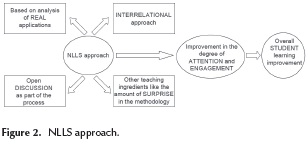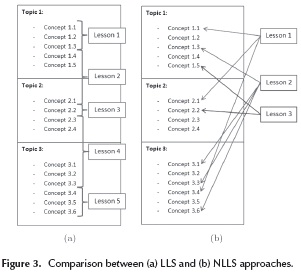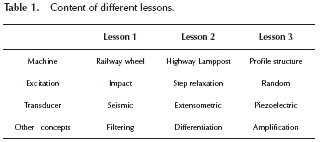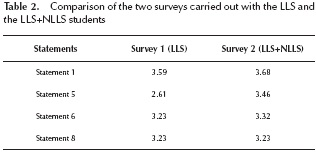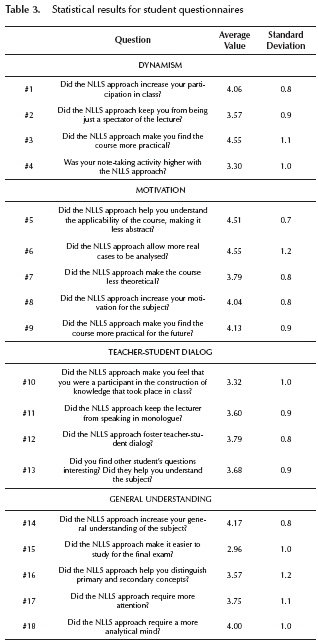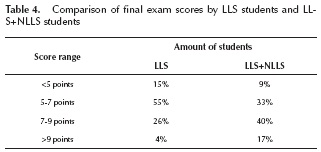Serviços Personalizados
Journal
Artigo
Indicadores
-
 Citado por SciELO
Citado por SciELO -
 Acessos
Acessos
Links relacionados
-
 Citado por Google
Citado por Google -
 Similares em
SciELO
Similares em
SciELO -
 Similares em Google
Similares em Google
Compartilhar
Ingeniería e Investigación
versão impressa ISSN 0120-5609
Ing. Investig. vol.35 no.3 Bogotá set./dez. 2015
https://doi.org/10.15446/ing.investig.v35n3.49644
Doi: http://dx.doi.org/10.15446/ing.investig.v35n3.49644.
The influence of a non-linear lecturing approach on student attention: Implementation and assessment
Influencia del enfoque de enseñanza no-lineal en la atención de los estudiantes: Implementación y evaluación
I. Merideno1, R. Antón2, and J.G. Prada3
1 I. Merideno: MSC, PhD Mechanical Engineer, Tecnun-Universidad de Navarra, Spain. Affiliation: Assistant professor, Tecnun-Universidad de Navarra, Spain.
E-mail: imerideno@tecnun.es.
2 R. Antón: Doctor Engineer, Electronics Cooling, Cardiovascular Fluid Mechanics, CFD, Heat Transfer, Engineering Education, Affiliation: Tecnun-Universidad de Navarra, Spain.
E-mail: ranton@tecnun.es.
3 J.G. Prada: Doctor Engineer, Tecnun-Universidad de Navarra, Spain.
E-mail: jgprada@tecnun.es.
How to cite: Merideno, I., Antón, R., & Prada, J.G. (2015). The influence of a non-linear lecturing approach on student attention: Implementation and assessment. Ingeniería e Investigación, 35(3), 1 15-120. DOI: http://dx.doi.org/10.15446/ing.investig.v35n3.49644
ABSTRACT
This paper presents a change made to the lecturing approach used within a specific course. The new lecturing approach is based on a non-linear structure where each lesson combines concepts from different topics, in contrast to the traditional linear structure in which each topic is treated separately. The objective of the non-linear approach is to increase student dynamism and motivation and to foster teacher-student dialog. Assessments from students who were taught according to the traditional linear structure along with assessments from students who were taught under both the linear and non-linear approaches are presented. Results show that the non-linear lecturing approach was welcomed and led to a higher degree of student dynamism and motivation and to more teacher-student dialog.
Keywords: Engineering education, non-linear approach, teaching mechanical engineering.
RESUMEN
Este artículo presenta el cambio realizado al enfoque de enseñanza de una asignatura específica. El nuevo enfoque está basado en una estructura no-lineal donde cada lección combina conceptos de diferentes temas, al contrario de la estructura lineal tradicional donde cada tema se trata de forma separada. El objetivo del enfoque no-lineal es incrementar el dinamismo y la motivación del estudiante y fomentar el diálogo profesor-estudiante. Se presentan las evaluaciones recogidas de los estudiantes que fueron enseñados mediante los dos enfoques: lineal y no-lineal. Los resultados muestran que el enfoque de enseñanza no-lineal fue bienvenido y dio lugar a un mayor nivel de dinamismo y motivación entre los estudiantes y a un mayor diálogo profesor-estudiante.
Palabras clave: Educación ingenieril, enfoque no-lineal, docencia en ingeniería mecánica.
Received: March 16th 2015 Accepted: October 3rd 2015
Introduction
Good lecturers are always looking for an increase in student learning; however, student material retention is hardly evaluated during a course, and it is often assessed through final exams, when it is too late to implement new measures that improve learning. Hake (1998) clearly demonstrated via a six-thousand-student survey that student capacity for learning is related to student attention. Since student attention is more easily measured during the course, lecturers are continuously improving the way they approach their courses in order to achieve high student attention rates and thus maximize material retention.
There have been several studies related to student attention. Johnstone and Percival (1976) gave rise to the widely known "rule of thumb", which states that students begin to stop paying attention between 10 and 20 minutes into a lecture. Hartley and Davis (1978) similarly concluded that student attention during a lecture lasts for about fifteen minutes, and after that most students show a loss in their retention of lecture material. Scerbo et al. (1992) and Bligh (1998) corroborated these conclusions through analysing students' note-taking activities and heart rates, respectively. Even though activity and heart rates cannot be measured in all courses, lecturers must be aware that increasing student dynamism involves increasing student attention, and presumably maximizing students' interest and material retention.
The question now is how to foster student attention, particularly in large-group lecturing contexts where it is more difficult to limit class size or incorporate more practical activities that ward off student passivity (Butler, 1992). Smith et al. (2005) conducted an important review of several lecturing methodologies like collaborative learning, project-based learning and combinations of these methodologies, and compared them with the traditional way of lecturing. The problem-based learning approach (Smith et al., 2005; Albanese et al., 1993; Norman et al., 2000; Martinez et al., 2010; Ihsen et al., 2011) also appears to be a more challenging, engaging and enjoyable approach to education. Any of these approaches can help students tackle a course in greater depth.
Another way to increase students' attention is by motivating them. Hake (1998) concluded that student attention levels are also related to the degree of student motivation. This motivation is related to both the lecturer's style (Turner, 1979) and the lecturing methodology (Smith et al., 2005). In order to motivate students in engineering education, Van Dijk and Jochems (2002) carried out an in-depth analysis on the use of interactive approaches. They emphasized the benefits of interrupting the monologue of traditional lectures and transforming the creation of knowledge into a conversation between lecturer and students. They concluded that interactive approaches result in higher student motivation, better study habits and increased learning. The advantage of this lecturing approach is that it can be applied even with large groups of students. Antón et al. (2009, 2011) also presented different ways of fostering student motivation and teacher-student dialog.
Recent studies also report the positive effects that the environment created by an instructional approach like problem-based blended instruction has on student engagement (Delialioglu, 2012) or that case-based instruction has on the conceptual understanding (Yadav et al., 2014; Esparragoza et al., 2015). However, Yadav et al. (2014) also stated that more research is needed in order to see what amount of knowledge is retained and applied in the future by students that are taught via a lecture-approach versus a case-based approach.
The present paper presents what we are calling the NonLinear Lecturing Structure (NLLS) approach, which aims to foster student dynamism, motivation and teacher-student dialog and by so doing increase student attention and ultimately maximize material retention.
Motivations and rationale for the study
Engineering courses generally follow what we call here a Linear Lecturing Structure (LLS) approach, which means that they are structured into different topics and subtopics that move from the basics to the deepest concepts and that are covered by the lecturer in class throughout the term. This structure generally matches up with the course notes or textbook, so students only have to follow the table of contents. Thus, both the textbook and the lessons follow the same linear structure.
The LLS approach offers several advantages: students know in advance what concepts will be taught in the next lesson, making it easier for them to prepare; lecturers can cover each subtopic separately and go into depth; lecturers have full control of what happens in class; and lecturers can usually predict the questions and discussions that are likely to arise. By mixing linear theoretical lessons with problem solving or practical activities, students can reach high levels of comprehension and retention. As is often the case, lecturer attitude also plays an important role in students' understanding and participation.
The course analysed in this paper is Machine Design and Testing (MDT), which is part of the Industrial Technologies Master's Degree at the Tecnun-University of Navarra in Spain. MDT is focused on the machine testing methods that are used to validate machine designs. In the traditional LLS approach to this course, the first lessons are devoted to modal analysis theory and reviewing the mathematical tools used. Basic vibration theory of single-degree-of-freedom and multiple-degree-of-freedom systems are introduced. The next lessons present different modal analysis methods, and students encounter dynamic exciters, transducers, signal conditioners and amplifiers, signal analysers, etc. In the last lessons, several concepts related to axle design and fatigue are explained. In total, the lectures cover 11 topics that coincide with the chapters of the textbook. Students also carry out experimental work in order to put the concepts learned into practice.
In September 2013, 54 students registered for MDT course. As is usual at our university, at the end of the term, the students were asked to give their opinion about the course on an anonymous survey. Twenty statements were listed, and students assigned a numerical value from 1 to 5 for each statement, with 1 indicating that a student totally disagrees with the statement and 5 indicating that a student totally agrees. Statements had a positive connotation, and thus higher values were related to high student satisfaction with the course.
MDT received 49 surveys from students (a participation rate of 90%), with an average score of 3.33 points. Among the twenty statements, four were related to the lecturing approach chosen by the lecturer. Others addressed the lecturer's punctuality, grading methodology, exam difficulty, etc. The statements related to the lecturing approach were the following:
-
Statement 1: The lecturer prepares and organizes the various course activities satisfactorily.
-
Statement 5: I think that the lecturer maintains my interest in the course during his lectures.
-
Statement 6: Student participation is encouraged in classroom lectures.
-
Statement 8: Theoretical lessons, practical work and other activities are well coordinated.
The scores for these statements are shown in Figure 1, with NR indicating non-responses. The number on each wedge indicates the number of students who gave the corresponding numerical value. It can be seen that statements 1, 6 and 8 received high scores. The responses to these three statements indicated that students felt that lectures were satisfactorily prepared and delivered.
Statement 5 received the lowest score of all the statements in the survey. In addition to this, the score for statement 5 seems incongruous with the high score for statement 6.
The fact that the students thought that the lecturer did not arouse interest was not related to the lecturer encouraging student participation.
The survey ended with a blank space where students could add comments and elaborate on their answers. From all the comments received, the most repeated and significant ones are the following: "lectures were monotonous and too theoretical"; "even though the lecturer was dynamic, it was often hard to pay attention"; and "more real applications were missing; the subject matter was too abstract".
These comments are evidence that the lecturer's style was not responsible for the short attention spans and that the fact that the lecturing methodology was not perceived as appropriate. The course was too theoretical and abstract, and the lecturer's dynamism was not enough to engage the students' interest. Something else was needed in order to eliminate the monotony.
This situation led to changing the lecturing approach from LLS to NLLS; this last approach will be explained in the next section. The purpose is not to criticize the LLS; there will always be cases where students are engaged through this approach. Nevertheless, the LLS was not the best solution for the MDT course, and it led to student passivity and boredom, and they became mere spectators.
The NLLS pedagogical approach
The NLLS approach can be summarized in Figure 2. It consists in using a real problem to explain several theoretical concepts in an interrelational approach (i.e. by showing the relationships among the concepts) and having an open discussion about how to solve the problem. This approach brings with it an element of surprise; since there is not a clear plan for students to follow, it makes them pay more attention. This, in turn, eventually increases the amount of learning that takes place.
As opposed to the LLS approach, where concepts are explained in isolated subtopics that follow a particular order, the NLLS approach has no defined order (see Figure 3). Lessons compound concepts from different subtopics, and their structure does not match up with the notes or the textbook for the course.
Even though the NLLS approach might look similar to the problem-based learning approach, they are substantially different. Problem-based learning is a useful methodology for illustrating theory in a given real problem that is normally solved by small groups of students through collaborative work. The NLLS approach is also a mixture; however, the difference lies in the fact that the real problem is used as the source for explaining theory rather than an illustration of the theoretical concepts in a particular problem. In the NLLS approach, the real problem is explained by the lecturer to all the students instead of having a small group of students tackle the problem.
In addition to avoiding a monotonous rhythm, this approach also gives the lecturers the opportunity to explain more real applications, which increases dynamism and motivation. Each lesson in the NLLS approach can be related to a real situation, where the concepts under study have to be used. In the case of the MDT course, each lesson was focused on one particular machine, explaining the most appropriate exciters, transducers, conditioners, etc. to use; other courses can do it in an analogous way. In this way, students related each concept to the machine it was applied to, so they learned the theory and its applicability at the same time, leading to a less theoretical environment even when the same, traditional concepts were being explained.
Moreover, the situations that students will face as engineers after they graduate do not evolve linearly, a fact that plays against the LLS approach. Instead, as engineers they will learn the skills they need to tackle problems as they are encountered, rather than being presented with structured, orderly opportunities to learn their skills. In this sense, the NLLS approach is closer to professional life, thus helping to develop soft skills and motivating, and it has the advantage of being adequate to use both in the classroom and in the laboratory.
With respect to the lecturer, the NLLS approach is more demanding than the LLS one. A LLS approach means the lecturer focuses on one topic in a time, but this new NLLS approach requires a higher degree of expertise in the content since the topics are presented all together.
Applying the NLLS approach
In September 2014, 69 students registered for the MDT course. This time, of the course's 11 topics, 5 were taught following the LLS approach and the other 6 followed the NLLS approach.
Despite the difficulties associated with the NLLS approach, it seemed to be an adequate alternative approach to lecturing in the MDT course. The elimination of monotony, a clearer overall perspective on the knowledge and a less theoretical impression were sought. In addition, the lecturers were optimistic that higher participation rates would result. Since the NLLS-based lessons would have a similar structure a machine is presented and the most -appropriate exciters, transducers, conditioners, etc. are discussed- students could say, at least, whether the devices studied previously were adequate or not for the actual machine.
For example, Table 1 shows the content of three NLLS-based lessons. Lesson 1 was concerned with the modal analysis of a railway wheel. In this lesson, impact excitation, seismic transducers (accelerometers) and signal filtering were introduced, since these devices were appropriate for a linear structure like a railway wheel. Lesson 2 studied a highway lamppost. Because it is a linear, elastic and slim structure, this lesson required that the step relaxation method, extensometric transducers (Wheatstone bridges) and signal differentiation be explained. Lesson 3 analysed a profile structure, where random excitation, piezoelectric transducers and operational amplifiers were required. This case also required that concepts linked to the structure being analysed, which presented strong non-linearities, be explained. As can be seen, in following the NLLS approach each lesson brought in concepts from different topics (exciters, transducers, signal processing, etc.).
Student assessment
Once again, at the end of the term the students were asked to give their opinion about the course. The same survey from Sec. 2 (Figure 1) was used. This time MDT received 62 surveys from students (a participation rate of 90%, equal to survey 1), with an average score of 3.37 points. Table 2 compares the scores obtained from the 49 students that took the course that used an LLS approach (survey 1) with the scores obtained from the additional 62 students that took the course that used both the LLS and NLLS approach (survey 2). In this case, statement 5 received a higher score (3.46 out of 5) and statements 1, 6 and 8 saw little change in their scores.
In order to evaluate whether the objectives sought with the NLLS approach had been reached, a new questionnaire was designed for the course. The response scale went from 1 to 5 (5 being a positive or affirmative answer and 1 being the opposite). Table 3 shows the questions given to the students and the statistical analysis of their responses.
The questionnaire was divided in four parts, each referring to a different objective. Sixty-one questionnaires (a participation rate of 88%) were voluntarily answered by the students. The mean value for each of the questions was obtained by considering a Gaussian distribution in the responses to each question. The students shared a rather uniform opinion, as is shown by the standard deviation value, which is around 1 (going from 0.7 to 1.2).
Finally, Table 4 shows a comparison of the scores (out of 10 points) that the LLS students and the LLS+NLLS students received on the final exam. The two exams had the same appearance and level of difficulty. Since the total number of students differed, Table 4 shows the percentage of the total students rather than absolute numbers.
Discussion
Firstly, with regard to the two surveys carried out in the two years (Table 2), the students that were lectured following an NLLS approach felt that lecturers generated more interest in the course than the students that were lectured following an LLS approach. Therefore, the NLLS approach helped students to take more interest in the course.
Secondly, in analysing the results from the student questionnaire (Table 3), it can be said that the NLLS approach was welcomed by the students. The results show that the NLLS-based lectures were less monotonous and more dynamic, leading to a less theoretical impression and greater motivation and fostering teacher-student dialog. In addition to this, the students had a better understanding of both the concepts and the general overview of the course. However, the students did not think that the NLLS approach made it easier to study for the final exam (question #15). This may be because of the lack of correlation between lectures and the textbook. They also do not think that the NLLS approach can be followed with the same degree of effort that the LLS approach requires, arguing that the NLLS approach requires more attention and a more analytical mind (questions #17 and #18).
Even though a comparison of the final exam scores achieved by the students from the two years is not significant because different students cannot be compared, they show that the students following a NLSS approach scored highly, which is always encouraging.
Finally, the comments received from the students and the lecturers' experience illustrate further points that should be taken into account when adopting the NLLS approach:
-
The amount of new concepts explained in the first few NLLS-based lessons should be limited. In the rest of lessons, since the new concepts are related to already known concepts and students are familiar with them, the number of concepts introduced can be increased.
-
Primary and secondary concepts should be clearly distinguished, because the interrelation of different topics can make this difficult for students.
-
Summaries are essential. Each lesson should end with a summary that highlights the new concepts and their particularities.
-
At the end of the course, a summary that puts together all the concepts explained also helps students to relate concepts from the same topic that have appeared in different lessons, giving them an overall view of the course.
-
A course textbook in which all the concepts are explained in a linear and structured way helps students to interpret a lesson and with subsequent study.
-
Having non-expert lecturers use the NLLS approach can have a significant negative effect, since this approach requires a higher degree of expertise than the LLS approach does.
-
Students should be mature enough to abstract the general concepts from the real cases. Therefore, the NLLS approach may not be adequate for students in the first years of their engineering degree.
Conclusions
Students who took the MDT (Machine Design and Testing) course as part of the Industrial Technologies Master's Degree at the Tecnun-University of Navarra in Spain were asked to complete an anonymous survey about their satisfaction within the course, as is standard procedure throughout the university. This survey provided the rationale of this work.
The survey showed that the students were not fully satisfied with the lecturing approach. Even though they appreciated the lecturer's dynamism, their opinion was that MDT was too theoretical and monotonous, and that more real applications were missing. Their interest was not engaged during the lectures.
This situation led to a change in the course. The structure of MDT shifted from a linear lecturing structure (LLS) approach to a non-linear lecturing structure (NLLS) approach where each lesson compounded concepts from different topics and was based on a specific real case. The organization of the course, where each topic was related to each stage of modal analysis, was appropriate for this new structure.
Assessments carried out before and after the new lecturing approach showed that the NLLS approach was less monotonous and more dynamic, leading to a less theoretical impression and greater motivation and fostering teacher-student dialog. In addition to this, the students had a better understanding of both the concepts and the general view of the course.
References [ Links ]
Antón, R., Gastelurrutia, J., Ramos, J.C., Rivas, A. & Larraona, G.S. (2013). Learning through a Multiple Approach Competing Practical Exercise -MACPE: a case study with a teacher's and a student's assessment. International Journal of Engineering Education, 27(4): 805-812. [ Links ]
Antón R., Jonsson H., Ramos J., Gómez-Acebo T. & Rivas A. (2009), Refrigerating cycle simulator: system modelling, Educational Implementation and Assessment, International Journal of Engineering Education, 25(2), 324-332. [ Links ]
Bligh D. (1998), What's the Use of Lectures?, Intellect. [ Links ]
Butler J.A. (1992), Use of teaching methods within the lecture format, Medical Teacher, 14(1), 11-25. DOI: 10.3109/01421599209044010. [ Links ]
Delialioglu D. (2012), Student engagement in blended learning environments with lecture-based and problem-based instructional approaches, Educational Technology & Society, 15(3), 310-322. [ Links ]
Dijk L.V. & Jochems W. (2002), Changing a traditional lecturing approach into an interactive approach: effects of interrupting the monologue in lectures, International Journal of Engineering Education, 18(3), 275-284. [ Links ]
Esparragoza I.E., Lascano Farak S., Ocampo J.R., Nuñez Segovia J., Vigan R., Duque-Rivera J. & Rodriguez C.A. (2015), Assessment of students' interactions in multinational collaborative design projects, International Journal of Engineering Education, 31(5), 1-15. [ Links ]
Hake R.R. (1998). Interactive-engagement versus traditional methods: A six-thousand-student survey of mechanical test data for introductory physics courses. American Journal of Physics, 66(1), 64-74. DOI: 10.1119/1.18809. [ Links ]
Hartley J. & Davies I.K. (1978). Note-taking: a critical review, Innovations in Education & Training International, 15(3), 207-224. DOI: 10.1080/0033039780150305. [ Links ]
Ihsen S., Schneider W., Walhoff F. & Blume J. (2011), Raising interest of pupils in Engineering Education through Problem Based Learning, International Journal of Engineering Education, 27(4), 789-794. [ Links ]
Johnstone A. & Percival F, (1976). Attention breaks in lectures. Education in Chemistry, 13(2), 49-50. [ Links ]
Martinez M., Romero G., Marquez J.J. & Perez J.M. (2010), Integrating teams in multidisciplinary project based learning in Mechanical Engineering, Education Engineering (EDUCON,) 2010 IEEE, 709-715. [ Links ]
Norman G. & Schmidt H. (2000), Effectiveness of problem-based learning curricula: theory, practice and paper darts, Medical Education, 34, 721-728. DOI: 10.1046/j.1365-2923.2000.00749.x. [ Links ]
Scerbo M.W., Warm J.S., Dember W.N. & Grasha A.F. (1992), The role of time and cuing in a college lecture, Contemporary Educational Psychology, 17(4), 312-328. DOI: 10.1016/0361-476X(92)90070-F. [ Links ]
Smith K.A., Sheppard S.D., Johnson D.W. & Johnson R.T. (2005), Pedagogies of engagement: classroom-based practices, Journal of Engineering Education, 94(1), 87-101. DOI: 10.1002/j.2168-9830.2005.tb00831.x. [ Links ]
Turner R.L. (1979), The value of variety in teaching styles, Educational Leadership, 36(4), 257-258. [ Links ]
Yadav A., Vinh M., Shaver G.M., Meckl P. & Firebaugh S. (2014), Case-based instruction: improving students' conceptual understanding through cases in a mechanical engineering course, Journal of Research in Science Teaching, 51(5), 659-677. DOI: 10.1002/tea.21149. [ Links ]














